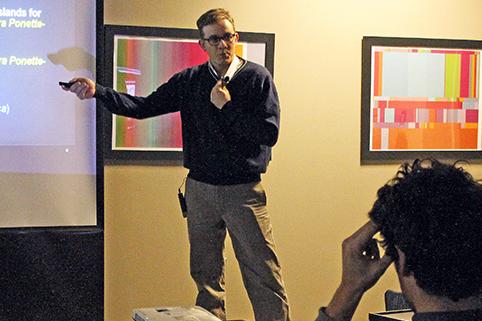
For the last several thousand years, humans have used agricultural terracing—the leveling of sloped land into “steps” that serve as planting beds—as a means to grow food where flat land is hard to find. Today, scientists believe that those same techniques can be adapted to help agricultural communities to conserve water and reduce soil erosion. Matthew LaFevor, postdoctoral fellow at the National Socio-Environmental Synthesis Center (SESYNC), wants to find the best ways to do that.
Dr. LaFevor’s research focuses on the use of semi-terracing, also called ditch-and-border terracing or zanja y bordo, as a means of water and soil conservation and to restore degraded landscapes and restore biodiversity in Latin America. Zanja y bordo, explains LaFevor, “has become an all-purpose strategy to repair degraded hill slopes, whether for producing agricultural goods or producing environmental services.”
LaFevor explains that his research seeks to answer four questions:
- Is zanja y bordo terracing an effective, sustainable means of soil and water conservation?
- What are the potential socio-environmental impacts of government terracing programs in Latin America?
- What can a global synthesis of data on terracing tell us about how forms function in different environments?
- How can synthesis research on terracing be used to improve environmental management?
At a recent seminar presented at SESYNC, LaFevor described two of the projects he’s working on: a global synthesis of data on hill-slope terracing—the first comprehensive analysis of its kind ever conducted—with Alexandra Ponette-González of the University of North Texas, and a study of the role of conservation terracing in the Revised Universal Soil Loss Equation (RUSLE) with Nick Magliocca of SESYNC. The results of these studies, LaFevor believes, will help government planners to improve their country’s environmental management techniques.
Terracing is an effective means of soil and water conservation, says LaFevor, but its effectiveness depends on both the design of the terracing and the environment in which it is used. The government of Mexico, for example, is using zanja y bordo terracing to restore degraded hard-pan surfaces throughout the country to preserve soils, but in some cases the use of this technique is actually exacerbating the problem. Without periodic maintenance, terraces can fail and cause landscape-level degradation.
To better understand the dynamics of terracing programs in Mexico, LaFevor is using data collected by that country’s largest land-development program to date, the Program for Sustainable Agriculture and Restoration of Degraded Lands (PIASRE), which ran from 2001 to 2007. He is analyzing the project’s database to identify the various terracing projects by state and establish their characteristics. Overall, LaFevor says, the data suggest that very little consideration was given to the type or location of terraces, which will likely lead to problems in the future.
LaFevor’s global synthesis of hill-slope terracing involved the creation of a database of over 800 scientific studies culled from scientific journals as well as studies published by NGOs and government agencies—and even historical maps that show agricultural features. LaFevor then uses a technique called thematic coding to highlight key information to make it easier to identify significant patterns and trends, and to present them in charts and tables that are easy to understand.
LaFevor’s research raises several important social and environmental questions. Different cultures use different terracing techniques; will these characteristics be visible in maps of terrace intensity? Do sociocultural differences in terrace design, such as spacing, have implications for water runoff and soil erosion? How do maps of terracing intensity in Mexico overlap with maps of conservation hazards and erosion? These are questions that LaFevor hopes to be able to answer as he continues his research at SESYNC.